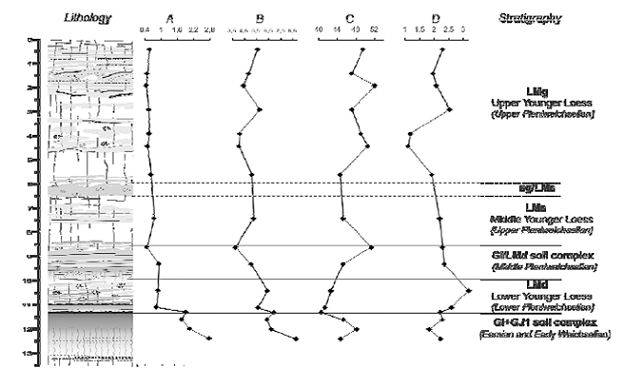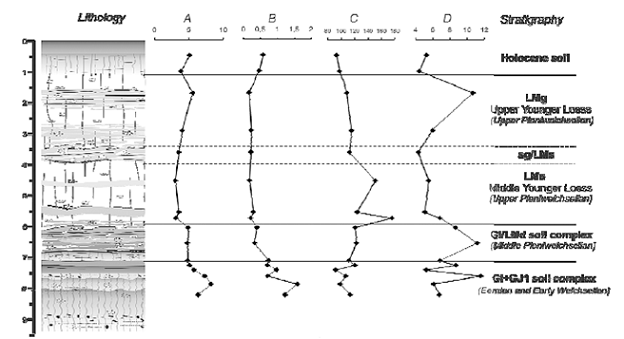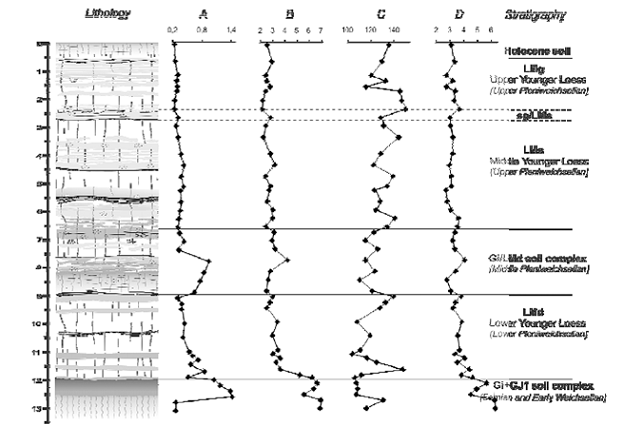LOESSFEST'09 | Aug. 31st – Sept. 3rd, 2009 |Novi Sad-Serbia
Geochemical Variations of Late Pleistocene Loess-Soil Sequence in Poland-Preliminary Results
Zdzisław Jary1, Ciszek, D.2, Raczyk, J.1
1Institute of Geography and Regional Development, University of Wroclaw, 50-137 Wroclaw, Poland
2Polish Geological Institute, Lower Silesian Branch, 53-122 Wroclaw, Poland
As a prelude of geochemical program of Late Pleistocene loess research in Poland three loesssoil sequences were chosen to detail examination: Dankowice (SW Poland – 35 km toward south from Wrocław), Polanów Samborzecki (Central Poland – near Sandomierz) and Tyszowce (E Poland – 35 km toward southeast from Zamość). The thickness of loess-soil sequences ranges between 9,3 and 13,5 m. Within these sections vertical successions have been selected for careful cleaning and sampling and documented in respect of their sedimentology, palaeopedology and stratigraphy. The following analyses were conducted: grainsize distribution (laser diffraction method), magnetic susceptibility, contents of CaCO3 and organic carbon, clay fraction mineralogy as well as TL, OSL dating. Geochemical analyses were performed in Soil Laboratory of Physical Geography Department of Wrocław University. Atomic absorption spectrometry (AAS) was used for analysis of major elements. Whole-sample major elements composition was presented as weight percentage of components. Weathering index (B) acc. Pye and Johnson (1988) was calculated and several molecular weathering ratios (A,C,D) were considered (Fig. 1, 2 and 3).
The results of loess geochemical analyses usually confirm former designation of main lithostratigraphic units. Whole-sample major elements composition allows to characterize them more precisely. The highest indexes of chemical weathering are characteristic of fossil soil units, particularly for both Interglacial – Early Glacial (Gi+GJ1) and Middle Pleniweichselian (Gi/LMd) fossil soil complexes. The substrate of these soils shows considerable transformation by soil processes. Weathering indices of loess units are generally much lower. However, slight variations is marked what proves different soil-weathering conditions during the main loess deposition phases. Geochemical investigations of loess-soil units enable us to recognise Late Pleistocene weathering conditions and some weathering ratios might be used as a potential proxy of environmental changes.

Fig. 1. Lithology, stratigraphy
and chosen weathering indices of Late Pleistocene loess-soil sequence at Dankowice: A - Al2O3/(CaO+MgO+K2O+Na2O); B - WI - weathering index (Al2O3+Fe2O3)/(Na2O+K2O) acc. Pye, Johnson (1988); C - SiO2/ TiO2; D - Fe2O3/TiO2.

Fig. 2. Lithology, stratigraphy and chosen weathering indices of Late Pleistocene loess-soil sequence at Polanów Samborzecki. Explanations as in figure 1.

Fig. 3. Lithology, stratigraphy and chosen weathering indices of Late Pleistocene loess-soil sequence at Tyszowce. Explanations as in figure 1.



